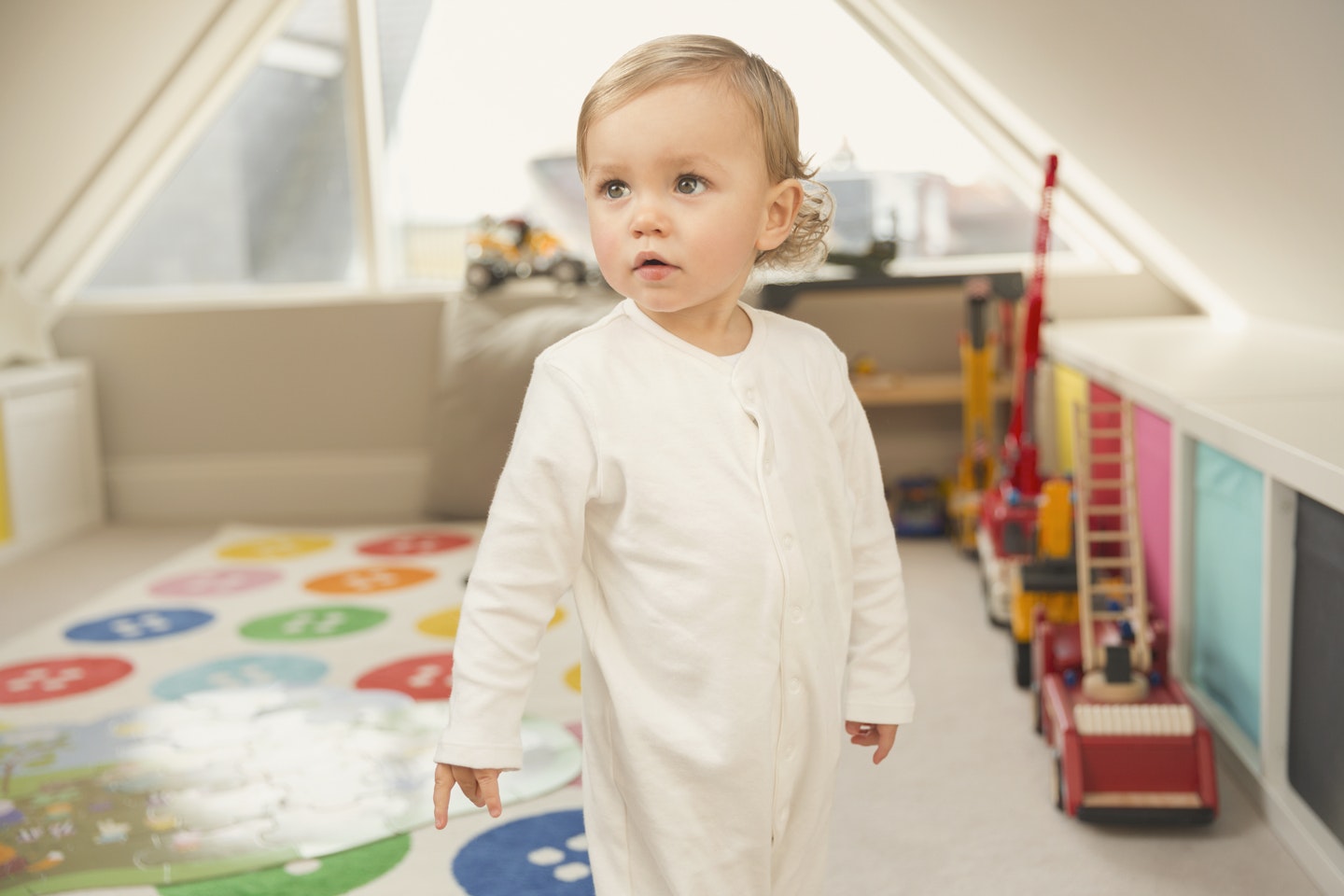Ah, sleep. It sounds so simple, doesn’t it? You put your tot to bed, he closes his eyes, soaks up hours of refreshing rest, and wakes with a smile on his face at 7am… But the reality for most of us, even when our babies are well past the stage of needing to feed during the night, is very different.
Lucy Wolfe is a baby sleep consultant, a mum of four and the author of The Baby Sleep Solution: The stay-and-support method to help your baby sleep through the night.
‘Sleeping well is a skill,’ says Lucy. ‘Learning to be a sound snoozer takes time, practice, a good sleep environment, and some dedicated help from parents.’ And there’s one fundamental skill your youngster has to master before he becomes a master of sleep: how to stitch his sleep cycles together.
‘Sleep isn’t one, long deep slumber,’ Lucy adds. ‘We all – babies and adults – sleep in cycles.'
We go from drowsiness to light sleep, then into to deep sleep to very deep sleep. And then it’s back the other way: from very deep sleep to deep sleep to light sleep. And it’s during the light-sleep stage that we dream, which is called REM (rapid eye movement) sleep.

‘When we move between deep sleep and light sleep, or when we’re in the light sleep stage, it’s much easier for us to be woken up,’ says Lucy. ‘And babies spend more time in light sleep and dream sleep than older children and adults, so they tend to wake up more than we do.’
If your tot is old enough to not need night feeds, but still wakes up lots, or if he never naps for longer than 40 minutes, then chances are, he hasn’t learnt this crucial skill yet. Understand how his sleep cycles work, and you can take some simple steps to help him master it. And once he can stitch together his sleep cycles, he’ll sleep well at night and nap happily during the day.
What’s your baby’s sleep cycle like?
Click through the gallery to discover your baby's sleep cycle...
Baby sleep guide
 1 of 4
1 of 4If you’re pregnant…
‘Your baby first started sleeping when he was in your womb,’ says Lucy. ‘This was mainly REM (rapid eye movement) sleep – the light sleep during which we have dreams.
Scientists have discovered that we spend more time dreaming when we are in the womb and when we are newborns than we do at any other time of life: probably because we are trying to process all the new sensations and experiences that are coming our way.’
 2 of 4
2 of 4From 0–4 months
‘In these months, your baby’s sleep pattern is immature,’ explains Lucy. ‘Your tiny baby has a tiny stomach, so milk passes through him quickly, which means he wakes up regularly to feed. Plus, he’s still spending a lot of time in REM sleep. As this is a light sleep, it’s much easier for him to be woken up.’
 3 of 4
3 of 4From 4–9 months
‘This is when your baby’s sleep pattern starts to mature,’ says Lucy. ‘His circadian rhythm (internal body clock) will have kicked in at three months old, so his body is now giving him regular prompts about when to eat, fall asleep and wake up.
By now he’s also producing the sleep hormone melatonin, another biological prompt that will help him fall asleep at night.’But your baby still has a relatively short sleep cycle – just 50 minutes long – and still spends a lot of time in REM sleep. ‘That means he’s still easily disturbed and may wake often,’ says Lucy.
 4 of 4
4 of 49 months plus
‘As your baby gets bigger, the amount of time he spends in REM sleep goes down and – at the same time – his sleep cycles start to get longer,’ says Lucy. ‘By the time he starts school, his sleep cycles will last around 90–100 minutes.
So, from nine months on, he’s spending more time in deep sleep. If he’s still waking up through the night or struggling with his naps at this stage, it’s a sign that he needs extra support from you to learn to stitch his sleep cycles together.’
What sleep stage are they in?

Watch your baby snoozing tonight, and you can easily tell which stage of his sleep cycle he’s in:
-
During REM sleep, you’ll see your baby’s eyes moving under his eyelids.
-
During light sleep, your baby might move about or twitch when he hears a sound.
-
During deep sleep, your baby won’t move and will be hard to wake.
If you can’t predict how long your baby will nap for…
…his sleep cycles are erratic. ‘Whatever age your baby, if his nap length is unpredictable it shows that there’s a sleep issue going on,’ says Lucy. ‘And your baby’s sleep cycles have probably become erratic because he’s overtired.’ That sounds contradictory, but babies have a stress response to being tired. Their brain thinks there must be a reason why they need to stay awake, so it releases the hormone cortisol, which has a stimulating ‘wake-up’ effect. That makes it harder for babies to get to sleep and to stay asleep, which leads to broken nights, tricky nap times and out-of-sync sleep cycles.
‘Dealing with this starts at bedtime,’ says Lucy, ‘because it’s at night that your baby will get most of his sleep, which sets his sleep cycles up for the next 24 hours. So, if you can get the night-time sorted, it becomes easier to resolve the day-time sleep.’ Plus, it’s in the early part of the night – up until midnight – that your baby spends most of his sleep cycle in deep, brain-soothing slumber. So, you need to:
-
Set a regular bedtime and wake-up time: ‘If you can, aim for bedtime between 6pm and 7.30pm and wake-up time between 6am and 7.30am,’ says Lucy. ‘This coincides with your baby’s natural sleep cycle, so he’ll benefit from a wave of body-clock-induced natural tiredness.
-
Have a consistent bedtime routine: ‘Bedtime routines help babies to settle into their sleep cycles because they cue them to know that sleep is coming,’ says Lucy. ‘Have a simple routine that’s no more than 30 minutes long – change nappy, into sleepwear, song, cuddle bed.’
-
Help your baby learn to settle himself: ‘The more help you give your baby to get to sleep, the more help he’ll need each time he wakes out of his sleep cycle,’ says Lucy. ‘Don’t rock him off to sleep. Put him into his cot when he’s awake and slowly and gradually reduce what you do to get him snoozing, so he learns to settle himself.’ This might take weeks but, as your tot gains the skills to settle himself, he’ll use them to stitch his sleep cycles together.
If your baby never naps for longer than 30 minutes…
…he’s not completing a full sleep cycle. ‘At the age of six months, a full sleep cycle is 40–50 minutes,’ says Lucy. ‘So, a 30-minute nap isn’t long enough for your baby to get the rest he needs. The first nap of the day might well be a short one: 40 minutes is adequate. But at least one of his naps – the late morning or early afternoon nap – should be over an hour long.’ To help your baby learn to sleep through a full cycle…
-
Separate feeds from nap time: ‘A regular feeding schedule supports good sleep,’ says Lucy. ‘Your baby needs to have a full tummy before he goes to sleep, so he isn’t waking up with hunger pangs. But he needs time to digest his feed before he goes to sleep – about 45 minutes before a nap and two hours before bedtime – so his stomach is relaxed.’ Leave some time between waking up and feeding, too: ‘Otherwise you might disrupt his sleep cycles because you’re encouraging him to wake up for food,’ says Lucy.
-
Have a really dark sleep environment: ‘To sleep well, babies need to be in a dark environment,’ says Lucy. ‘Use a black-out blind for day time sleeps as well as at night time. It can make the difference between your baby sleeping for less than one sleep cycle, or staying asleep for two.’
-
Nap at home: ‘Once your baby’s sleep patterns start to mature (around four months old), try to limit the amount of time he naps on the move,’ says Lucy. ‘When he’s napping on the move, his brain stays in the lighter sleep phase and can’t cycle through into deep, restorative sleep.’
If your toddler still wakes up all through the night…
…he’s not learned how to stitch his sleep cycles together. ‘Check that your baby isn’t overtired, isn’t hungry and his room is dark, quiet and at the right temperature,’ says Lucy. ‘If all those things are in place, but he’s still only napping through one sleep cycle, then you need to spend seven days – in a row – using my stay-and-support method to encourage him to keep sleeping. The details are in my book, but it’s a low-key way of gently teaching him to settle himself. I recommend spending 30-40 minutes each day trying to get him back to sleep after he wakes at the end of the first sleep cycle.’
If your tot won’t sleep after 5am…
…he’s struggling to manage his last sleep cycle. ‘That hour to hour-and-a-half in the early morning is the last sleep cycle of the night,’ says Lucy, ‘and it’s the hardest one to achieve. That’s because by 5am your baby has enjoyed a big helping of sleep in the night, so he’s not so tired. To help him manage this last sleep cycle better:
Check there’s a gap before bedtime: ‘To avoid overtiredness or early waking in the morning, it’s important to get the right gap between the last nap of the day and bedtime,’ says Lucy. Up to the age of three months, he should be awake for 30 minutes to one hour before bedtime. From four to six months, that increases to between one and two hours; from six to eight months to two to three hours; from eight to 11 months to between two and four hours; from 12-18 months to between three and five hours; and from 18 months to three years to between four and five hours.
Don’t nap before 9am: ‘If your baby is waking early and then he’s having an early nap before 9am, it will shift his sleep schedule and all his sleep gets earlier, which reinforces that early wake-up,’ says Lucy. If this has happened, shift his first nap of the day back by five minutes every day until you’ve nudged it to 9am. ‘This can be tricky – you may need to do lots of distraction to stop him nodding off – but it’s worth it!’ says Lucy.
Meet the Expert: Lucy Wolfe is a baby sleep consultant, a mum of four and the author of The Baby Sleep Solution: The stay-and-support method to help your baby sleep through the night
Read more popular articles
When to start sleep training | Sleep training methods explained
